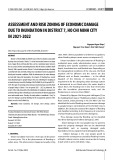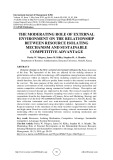
ECONOMICS - SOCIETY https://jst-haui.vn HaUI Journal of Science and Technology Vol. 60 - No. 11E (Nov 2024)
86
P
-
ISSN 1859
-
3585
E
-
ISSN 2615
-
961
9
ENVIRONMENTAL SUSTAINABILITY IN VIETNAM: THE ROLE OF ALTERNATIVE ENERGY, GDP GROWTH, NATURAL RESOURCES
Nguyen Manh Hung1,* DOI: http://doi.org/10.57001/huih5804.2024.347 ABSTRACT Vietnam, significantly impacted by
climate change, aims for net zero
emissions by 2050, supported by the National Climate Change Strategy and
the Just Energy Transition Partnership (JETP). Despite these efforts, Vietnam’s
Power Development Plan 8 (PDP8) indicates continued fossil fuel relia
nce
until at least 2030. This study examines the impact of alternative energy
resources, natural resources, and government spending on Vietnam's
ecological sustainability from 1990 to 2021, using the Environmental Kuznets
Curve (EKC) framework. The finding
s reveal an inverse relationship between
CO2 emissions and renewable energy use and natural resources, while CO2
emissions positively correlate with economic growth, contradicting the EKC
hypothesis. Effective policies require equitable distribution and ad
herence to
regulations. Vietnam should enhance renewable energy adoption, enforce
stricter regulations on natural resource exploitation, integrate environmental
impact assessments into economic planning, and foster public awareness and
education on sustain
able practices. These strategies will support Vietnam’s
transition to a sustainable economy, aligning economic growth with
environmental preservation. Keywords:
Carbon emissions, environmental sustainability, alternative
energy, natural resources, net zero emissions, Vietnam, EKC. 1East Asia University of Technology, Vietnam *Email: hungnm@eaut.edu.vn Received: 10/5/2024 Revised: 17/7/2024 Accepted: 28/11/2024 1. INTRODUCTION The global community is increasingly concerned about various ecological changes, such as climate change, desertification, deforestation, coastal erosion, overfishing, biodiversity loss, and soil degradation. These issues collectively signify significant alterations to Earth's surface driven by human activity. Vietnam, which is one of the countries affected the most by the climate change while possessing abundant of natural resources, has announced its commitment to achieve the target of net zero emissions by 2050 during the COP26 World Leaders' Summit in 2021. Following by the approval of Prime Minister’s Decision No.896/QD-TTg guiding the National Climate Change Strategy, which aims to guide Viet Nam’s climate action through 2050. While this decision is a legal document, the target has yet to be formalized in legislation and relies on international financial support. Viet Nam has signed the Just Energy Transition Partnership (JETP) with an international coalition of donors, aiming to assist in transitioning away from coal toward clean and renewable sources of energy while supporting the prospering economy. Additionally, Vietnam's National Electricity Development Plan 2021 - 2030 recently promulged reflects its commitment to accelerating the transition from conventional fossil fuels to cleaner and renewable energy sources, addressing environmental concerns, reducing greenhouse gas emissions, and aligning with global sustainability targets. The strategy states that Viet Nam will not develop new coal-fired power plants after 2030 and will gradually reduce its coal fleet after 2035. However, the Power Development Plan 8 (PDP8) indicates that the power sector will still depend extensively on fossil fuels until at least 2030, with substantial new gas infrastructure being developed. The prospects for phasing out the fossil fuel fleet are uncertain and depend on plans to convert existing plants to alternative fuels. Vietnam's National Electricity Development Plan 2021 - 2030 additionally reflects its commitment to

P-ISSN 1859-3585 E-ISSN 2615-9619 https://jst-haui.vn ECONOMICS - SOCIETY Vol. 60 - No. 11E (Nov 2024) HaUI Journal of Science and Technology
87
transitioning from conventional fossil fuels to cleaner and renewable energy sources. By 2030, Vietnam aims to diversify its energy mix significantly, planning to increase capacities in thermal, LNG thermal, and coal-fired thermal power plants to 14,930MW, 22,400MW, and 30,127MW, respectively. Renewable energy sources will also be ramped up, with offshore wind, onshore wind, and biomass power capacities reaching 6,000MW, 21,880MW, and 1,088MW, respectively. Additionally, electricity generated from waste is expected to contribute 1,182MW, alongside 2,600MW of rooftop solar power and 300MW of battery storage capacity. This study examines the impact of alternative energy resources, natural resources, and government spending on Vietnam's ecological sustainability from 1990 to 2021, using the environmental Kuznets curve (EKC) framework. Employing all the public recognized data from World Bank, our findings reveal an inverse relationship between carbon dioxide (CO2) emissions and renewable and nuclear energy use, natural resources, and government expenditure. Conversely, CO2 emissions are positively correlated with economic growth, acceleratingly associated with the square of economic growth, contradicting the EKC hypothesis. This indicates that fast economic growth harms environmental sustainability. The study concludes with policy implications, identified research gaps, and suggestions for future research. 2. LITERATURE REVIEW The measurement of carbon emissions employs various models and theories to assess the impact of climate change efficiently. Increased fossil fuel use and deforestation have led to the development of numerous CO2 emission analysis methods. A key concept is the Environmental Kuznets Curve (EKC) model, which suggests a U-shaped relationship between economic growth and pollution. Initially conceptualized by Simon Kuznets in the 1950s in relation to income inequality, this concept was later adapted to environmental economics and gained prominence in the early 1990s with the work of Grossman and Krueger [1], who explored the impact of economic growth on environmental quality in their study on the North American Free Trade Agreement (NAFTA). They found empirical evidence suggesting that certain pollutants decreased after a threshold level of income was reached. Following this, the EKC hypothesis has been extensively studied and debated in the fields of environmental and development economics. The paper "Economic Growth and Environmental Quality: Time-Series and Cross-Country Evidence" by Nemat Shafik and Sushenjit Bandyopadhyay [2] explores the relationship between economic growth and environmental quality through the analysis of patterns of environmental transformation at different income levels which posits that environmental degradation initially increases with economic growth but eventually decreases as income reaches higher levels. Studies of "Economic Growth and the Environment" by Theodore Panayotou [3] have shown that pollutants like sulfur dioxide (SO2) and particulate matter (PM) follow the EKC pattern with turning points at various income levels. The hypothesis suggests that in the early stages of economic growth, environmental degradation and pollution levels increase, but after reaching a certain level of income per capita, further economic growth leads to environmental improvements. Economic growth initially leads to environmental degradation but eventually improves environmental quality. This theory has been validated in several studies showing that economic growth can either increase or reduce emissions. Numerous studies have explored the relationship between energy efficiency, renewable energy intensity, and environmental sustainability, providing empirical evidence that supports the EKC hypothesis. In their 2015 study titled "How effective are energy efficiency and renewable energy in curbing CO2 emissions in the long run? A heterogeneous panel data analysis" [4] Özbuğday and Erbas found that energy efficiency significantly reduces CO2 emissions. Their research utilized a panel data approach, accounting for heterogeneity and cross-sectional dependence among countries, to reveal that improvements in energy efficiency have a long-term mitigating effect on CO2 emissions. In their 2022 study titled "Impact of energy efficiency on CO2 emissions: empirical evidence from developing countries" published in Gondwana Research [5], Mirza et al. demonstrated that energy efficiency exerts a more significant influence on reducing CO2 emissions in developing countries compared to structural shifts resulting from economic activities. Their research highlighted that while economic growth and industrialization contribute to carbon emissions, improvements in energy efficiency play a more crucial role in mitigating these emissions across the examined developing nations. Mirza et al. provided robust empirical evidence that enhancing energy efficiency can lead to substantial reductions in CO2

ECONOMICS - SOCIETY https://jst-haui.vn HaUI Journal of Science and Technology Vol. 60 - No. 11E (Nov 2024)
88
P
-
ISSN 1859
-
3585
E
-
ISSN 2615
-
961
9
emissions, thereby underscoring its importance in achieving sustainable environmental outcomes. Similarly, in the paper titled "Toward a sustainable mitigation approach of energy efficiency to greenhouse gas emissions in the European countries" published in Heliyon in 2020 [6], Akdag and Yildirim demonstrated that energy efficiency decreases greenhouse gas (GHG) emissions in the European Union and Turkey. By employing a combination of Granger causality and long-run estimators like fully modified and dynamic ordinary least squares (FMOLS and DOLS), they provided robust evidence that enhanced energy efficiency leads to significant reductions in GHG emissions. Additionally, Özkan, Alola, and Adebayo, in their paper "Environmental benefits of non-renewable energy efficiency and renewable energy intensity in the USA and EU: Examining the role of clean technologies," published in Sustainable Energy Technologies and Assessments [7], analyzed the environmental performances of the USA and the EU in response to non-renewable energy efficiency, renewable energy intensity, and environmental-related technologies from 1990 to 2019. Using Kernel-Based Regularized Least Squares and robustness measures, the study found that non-renewable energy efficiency, renewable energy intensity, and environmental technologies significantly mitigate greenhouse gas (GHG) emissions in both economies emphasizing that increasing efficiency in non-renewable energy use and enhancing renewable energy intensity are crucial strategies for reducing GHG emissions and achieving environmental sustainability. In the context of France, Ridwan et al. in their paper titled "Environmental Sustainability in France: The Role of Alternative and Nuclear Energy, Natural Resources, and Government Spending" [8] examined the impacts of alternative and nuclear energy, natural resources, and government spending on France's ecological sustainability from 1990 to 2021. The study employed the EKC framework, using fully modified least squares (FMOLS) and dynamic ordinary least squares (DOLS) for long-run estimates. Their findings indicate an inverse relationship between CO2 emissions and the use of renewable and nuclear energies, natural resources, and government spending, while a positive relationship is observed between CO2 emissions and economic development. The results support the EKC hypothesis, suggesting that as the economy grows, environmental sustainability initially declines but improves in the long run underscoring the importance of promoting alternative and nuclear energy, implementing sustainable resource management policies, and directing government spending towards environmental protection and sustainable practices to achieve substantial environmental benefits and support sustainable development goals. These studies collectively emphasize the importance of energy efficiency as a key factor in reducing environmental degradation and align with the principles of the EKC hypothesis. They highlight the potential for energy efficiency measures to achieve substantial environmental benefits, supporting sustainable development goals. Factors such as foreign direct investment, financial development, and energy research influence emissions. There is though a research gap in understanding the environmental impacts of alternative and nuclear energy shares on energy consumption and supply, natural resources, and government spending in Vietnam. This study aims to fill this gap by analysing these factors' impact on CO2 emissions within the EKC context. The study concludes with policy implications, identified research gaps, and future research suggestions. 3. METHODOLOGY 3.1. Theoretical framework Numerous studies have investigated the relationship between environmental sustainability, renewable energy usage, and economic development. Several linear and nonlinear impacts of economic growth are examined, along with their effects on environmental sustainability, natural resources depletion, and more. Renewable energy sources such as sunlight, wind, and water are primary contributors to green energy. In contrast to carbon-emitting fossil fuels, these renewable sources represent a sustainable alternative. The rising demand for already scarce natural resources has been exacerbated by various factors, including population growth and changing weather patterns. The quality of water supply and watersheds is deteriorating due to increasing household, industrial, and agricultural demands. Consequently, watersheds and irrigated fields are losing their integrity and functionality. Furthermore, deforestation, overgrazing, salinization, and erosion are increasing, severely impacting people living in poverty who rely on natural resources for their livelihoods. Governments play a crucial role in regulating polluters, maintaining water quality through taxation, and

P-ISSN 1859-3585 E-ISSN 2615-9619 https://jst-haui.vn ECONOMICS - SOCIETY Vol. 60 - No. 11E (Nov 2024) HaUI Journal of Science and Technology
89
controlling the environmental impact of certain industries. Economic growth influences the country’s actual output by increasing economic activities. However, increased production and consumption can harm ecosystems. Ecological impacts of economic development include global temperature rise, depletion of non-renewable resources, increased pollution, and Table 1. Data on Vietnam CO2 Emissions, Renewable Energy Consumption. Natural Resources Rent, Population, GDP, Consumption Expenditure and Trade
C RE N P U T C GDP GDP2 Year Vietnam CO2 Emission in Mega Tons (Mt) Renewable energy consumption (% of total final energy consumption) Total natural resources rents (% of GDP) Vietnam Total Population
Urban population (% of total population) Trade (% of GDP) Final consumption expenditure (% of GDP) Vietnam GDP in billion USD Vietnam GDP squared 1990 19.33 75.91 12.33 66.91 20.3 81.3
6.47 41.88 1991 19.80 75.46 8.02 68.36 20.6 66.9
9.61 92.42 1992 20.81 74.52 10.26 69.79 21.0 73.6
9.87 97.36 1993 24.24 70.62 7.69 71.18 21.4 66.2
13.18 173.74 1994 26.68 67.77 6.74 72.50 21.8 77.5
16.29 265.25 1995 31.40 64.88 7.28 73.76 22.2 74.7 81.80 20.74 429.99 1996 35.03 62.61 7.00 74.95 22.6 92.7 82.79 24.66 607.99 1997 40.84 60.53 5.75 76.06 23.0 94.3 79.90 26.84 720.58 1998 45.47 59.23 4.56 77.13 23.4 97.0 78.51 27.21 740.36 1999 46.41 59.32 5.64 78.12 23.8 102.8 75.43 28.68 822.75 2000 51.21 57.73 9.69 79.00 24.4 111.4 72.88 31.17 971.73 2001 56.72 56.14 7.98 79.82 24.9 112.0 71.18 32.69 1068.32 2002 66.50 52.2 7.43 80.64 25.5 116.7 71.33 35.06 1229.49 2003 70.90 50.83 7.95 81.48 26.1 124.3 72.58 39.55 1564.40 2004 85.05 45.77 11.76 82.31 26.7 133.0 71.47 45.43 2063.69 2005 92.37 44.15 12.13 83.14 27.3 130.7 70.95 57.63 3321.59 2006 94.87 44.25 12.23 83.95 27.9 138.3 70.62 66.37 4405.20 2007 105.14 41.9 11.41 84.76 28.5 154.6 73.66 77.41 5992.99 2008 117.59 39.26 13.92 85.60 29.1 154.3 76.50 99.13 9826.82 2009 132.29 36.97 7.40 86.48 29.8 134.7 74.27 106.01 11239.11 2010 151.41 34.58 7.48 87.41 30.4 114.0 68.82 147.20 21668.19 2011 155.97 36.33 9.07 88.35 31.1 125.3 66.47 172.60 29789.05 2012 155.52 37.91 7.30 89.30 31.8 123.2 66.15 195.59 38255.71 2013 164.30 37.37 5.91 90.27 32.4 130.8 67.80 213.71 45671.46 2014 180.70 36.69 5.66 91.24 33.1 135.4 67.33 233.45 54499.59 2015 201.51 26.54 3.38 92.19 33.8 144.9 69.99 239.26 57244.55 2016 222.03 26.97 2.68 93.13 34.5 145.4 69.14 257.10 66098.35 2017 229.88 28.52 3.21 94.03 35.2 161.0 68.13 281.35 79159.85 2018 286.14 24.59 3.26 94.91 35.9 164.7 66.82 310.11 96166.03 2019 341.72 20.65 2.50 95.78 36.6 164.7 66.41 334.37 111800.13 2020 355.32 19.11 1.81 96.65 37.3 163.2 65.45 346.62 120142.47 2021 0.00
2.55 97.47 38.1 186.4 65.05 366.14 134056.72 2022 0.00
98.19 38.8 185.7 63.92 408.80 167119.38 Source: World Bank Open Data

ECONOMICS - SOCIETY https://jst-haui.vn HaUI Journal of Science and Technology Vol. 60 - No. 11E (Nov 2024)
90
P
-
ISSN 1859
-
3585
E
-
ISSN 2615
-
961
9
habitat loss. While no method of economic growth is inherently detrimental to the environment, increased disposable income can lead to more investment in environmental causes. Technological advancements can also help mitigate environmental damage, indicating that a thriving economy can support environmental sustainability. The Environmental Kuznets Curve (EKC) model provides a theoretical framework for understanding the relationship between economic development and environmental degradation. According to the EKC hypothesis, environmental degradation initially worsens as an economy grows, but improves after reaching a certain level of economic maturity. This inverted U-shaped curve suggests that while industrial growth leads to environmental damage, post-industrial economies tend to adopt cleaner technologies and more efficient resource management practices, ultimately enhancing environmental quality. However, not all pollutants follow this pattern, and the increased prosperity does not necessarily slow the consumption of finite resources. For instance, reducing pollution in one country by importing coal from poorer nations can lead to environmental degradation elsewhere. Often, long-term environmental concerns are overlooked in favor of addressing immediate challenges. 3.2. Data description From 1990 through 2022, this research uses the EKC model to examine how the Vietnam Trade, Urbanization rate, population, GDP, and the usage of alternative energy sources will affect Vietnam's environmental sustainability. Emissions of CO2 are reported in Mt. The percentage of ultimate energy consumption that came from renewable sources was calculated. GDP was used because it is a consistent indicator of economic growth in US dollars. All the information for the yearly series comes from the World Bank Open Data Sources. 3.3. Econometric model The assumption is formulated that the Vietnam GDP will follow the EKC model hypothesizing relationship between environmental quality improvement and economic development growth in Vietnam and its economic growth will eventually lead to environmental sustainability. However, relying solely on economic growth without active environmental policies may not lead to the desired outcomes. We need to consider other factors that may affect the Vietnam’s Path toward sustainability represented by the CO2 Emissions. Based on the EKC, this research paper investigates the impacts of renewable energies and natural resources, population growth, urbanization rate alongside government spending on Vietnam's ecological sustainability throughout 1990 - 2022. But due to the lack of data on government, the suggested empirical model is denoted by the subsequent equation: Ct = b0 + b1REt+ b2Nt + b3Pt + b4Ut + b5Tt + b6Ct + b7GDPt + b8GDP2t Where RE is alternative energy, N is natural resources rent, P is the population in million, U is the urbanization rate, T is the total trade in % of GDP, C is final consumption in % of GDP, GDP is the economic growth (GDP) and GDP2 is the square of GDP. Additionally, the dependent variable C is CO2 emissions. Besides, b0 is the intercept and t reflect the time series (1990 to 2021). In addition, b1 to b8 denote the coefficients. 3.4. Estimation strategies Testing all the regression models ought to be introduced to determine the most influencing factors. Sometimes, in economic and financial theory, it is assumed that non-stationary time series variables have some sort of long-term equilibrium relationship. By testing the model, we can find the most suitable model for explaining the correct sustainability factors in Vietnam. 4. RESULTS AND DISCUSSION 4.1. Result 1. CO2 influenced by factors of RE, N, P, U, T, C, GDP, GDP2 The statistical results of many normality tests are also shown in Table 2. CO2 emissions, renewable energies, natural resources, government spending, and economic progression are all summarized. All these variables have a normal distribution, as seen by the high degree of concordance between their means, medians, maximums, and minimums. The regression model provided is highly significant, explaining 99.6% of the variance in CO2 emissions based on multiple predictors: GDP, GDP squared (GDP2), Renewable Energy (RE), Natural Resources (N), Population (P), Urbanization Rate (U), Trade (T), and an additional variable (C). The exceptionally high R2 value (0.996) and Adjusted R2 (0.994) indicate a near-perfect fit, suggesting that the included predictors are very effective in capturing the variations in CO2 emissions. This high explanatory power is crucial for making accurate predictions and understanding the main drivers of CO2


























